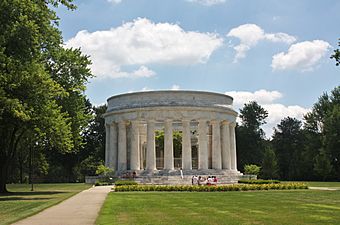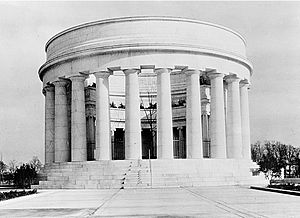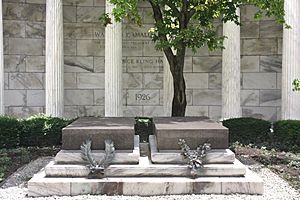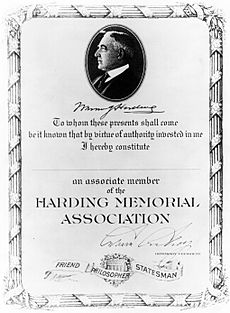Harding Tomb facts for kids
Quick facts for kids |
|
|
Harding Tomb
|
|

Front (northern side) of the Harding Tomb
|
|
| Location | Marion Cemetery, Marion, Ohio |
|---|---|
| Area | 2 acres (0.81 ha) |
| Built | 1926 |
| Architect | Henry Hornbostel |
| NRHP reference No. | 76001485 |
| Added to NRHP | June 16, 1976 |
The Harding Tomb is a special place in Marion, Ohio. It is where the 29th President of the United States, Warren G. Harding, and his wife, First Lady Florence Harding, are buried. This grand memorial is also known as the Harding Memorial. It was one of the last very fancy tombs built for a U.S. president.
Contents
Building a Special Place
After President Harding passed away while in office, a group called the Harding Memorial Association was formed. Their goal was to collect money to build a memorial to honor him.
They managed to raise almost $1 million. More than a million people from all over the country donated. Even some countries in Europe helped out. About 200,000 school children in the United States gave pennies to help build this memorial. The tomb is located in Marion, Ohio, near the Marion Cemetery.
Design and Look
Building the memorial started in 1926 and was finished in early 1927. It looks like a round Greek temple. It has tall, strong marble columns in a style called Doric order. These columns are made of white marble from Georgia. They stand 28 feet (about 8.5 meters) high and are 5 feet (about 1.5 meters) wide at the bottom.
The whole building is 103 feet (about 31 meters) wide and 53 feet (about 16 meters) tall. It was designed by Henry Hornbostel, Eric Fisher Wood, and Edward Mellon. They won a national contest in 1925 for their design.
An Open-Air Design
The memorial does not have a roof over its center. This is like some ancient Greek temples that were open to the sky. This open design was chosen because the Hardings wanted to be buried outdoors. The area is now covered with ivy and other plants, making it a peaceful, natural space.
Resting Place
When President Harding and Florence Harding passed away, their bodies were first placed in the Marion Cemetery Receiving Vault. Once the Harding Memorial was ready in 1927, their bodies were moved to the memorial's special stone coffin, called a sarcophagus, and sealed inside.
The memorial was not officially dedicated until 1931. This was because there were some challenges and discussions about President Harding's time in office. President Herbert Hoover led the dedication ceremony.
The Dedication Ceremony
On June 16, 1931, President Herbert Hoover gave a speech at the dedication of the Warren G. Harding memorial. He spoke about how the monument showed the public's respect for Harding.
President Hoover mentioned that Harding came from ordinary people. He had to lead the country after a big war. Hoover said that Harding brought kindness and friendship to the presidency. He also praised Florence Harding, saying she worked hard beside her husband throughout his life.
Hoover shared a story about Harding offering help during the war. He described Harding as a man of honor, with a kind heart and a deep love for his country. He said Harding was devoted to others and gave his life serving the United States.
Who Takes Care of It Now?
In the 1980s, the Harding Memorial Association gave ownership of the memorial to the Ohio History Connection. This group is also known as the Ohio Historical Society (OHS). OHS worked to restore the memorial in the mid-1980s. They started calling it the Harding Tomb, which better describes what it is.
In 2011, the Ohio Historical Society made a new plan. They transferred the daily care of the memorial, and the nearby Harding Home, to Marion Technical College (MTC). This helped OHS with its workload. MTC now helps manage the site, while OHS still owns it and works with MTC on big decisions.
A Look at Presidential Tombs
The Harding Memorial is the last of the very elaborate tombs built for U.S. presidents. This trend of grand burial sites started with President Abraham Lincoln's Lincoln Tomb in Springfield, Illinois. Since President Calvin Coolidge, who became president after Harding, presidents have chosen simpler burial places. Many later presidents are buried in designs that are less grand or are combined with their presidential library sites.






